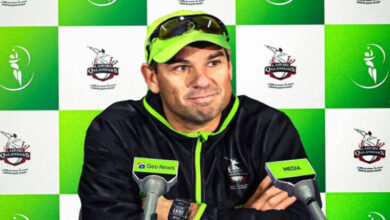What the ice-cricket tournament tells us about India-Pakistan cricket relations


There’s not much in cricket Virat Kohli doesn’t know about. The Indian captain could yet go down as his country’s greatest batsman, having met most of the requirements already. He has won a World Cup and a Champions Trophy, is on course to beat Sachin Tendulkar’s mark of 49 ODI centuries, and still has about half a career ahead of him.
And as Indian and Pakistani players, among a handful of others from the ’90s and 2000s, goofed around at an exhibition event in Switzerland, playing cricket in the ski resort of St Moritz at sub-zero temperatures, you couldn’t help but cast your mind to Kohli. There is, after all, one special feeling in cricket he might never get the opportunity to sample: lining up in a Test match against Pakistan.
The St Moritz Ice Cricket tournament was an event between star players of yesteryear in conditions that are the antithesis of those in which the summer game is played. The players themselves were well past their peak years, most in their late 30s, 40s, and in Wasim Akram’s case, 50s. They were unfit, not especially motivated, and scarcely recognisable as the giants we once watched on TV. They were also wrapped up in woollen scarves and jackets, wearing gloves to keep the relentless Swiss winter at bay.

But as you watched more of it (and who can blame you if you didn’t?), you began to sense that cricket wasn’t really the point. The easy camaraderie between once fierce rivals made you feel warm and fuzzy despite the snowy backdrop. At no stage was this more poignant than when Indian and Pakistani players and fans interacted with each other. There was a point where Mohammad Kaif hit Abdul Razzaq for three sixes in a row before Razzaq managed to york him. The pair met in the middle of the pitch, wide grins on their faces, giving each other a high five.
Even Virender Sehwag, hardly a dove in his views on India-Pakistan relations, appeared to have caught the bug. He took Shoaib Akhtar to task in both games, before joking that he thought he’d be facing a fast bowler. He clowned around with Shahid Afridi and Akram at the toss. The bonhomie with the Pakistan players was as surprising as it was welcome.
But the moment of the event, and what may yet be one of the feel-good cricketing moments of the year, came after the second game when Afridi stood at the boundary, signing autographs for the pocket of fans who were around to watch. As the diehards clamoured, a young girl with an Indian flag in hand asked for a picture. As Afridi granted the request, the fan withdrew the flag she’d been holding, folding it up and out of the frame, presumably so as not to offend Afridi.
He picked up on it, and almost chastised her, asking her to unfurl the flag properly. It was a moment warm enough to have melted the snow beneath their feet. That picture of a Pakistan player with the Indian flag in the foreground might well, in today’s environment, be vulnerable to all sorts of misinterpretation and malice, but the decency of the gesture is worth more than a thousand words.
India v Pakistan isn’t, as we’re told ad nauseum, like the Ashes rivalry. It isn’t a rivalry that took its root organically from the cricket, or is only about that; it was destined to be one from the moment the two nations went their separate ways over seven decades ago. Wins on the field for either side are hailed almost as military victories, with match analysis and reporting on news channels on both sides easy to confuse with war correspondence. The depth of animosity, and frankly, hatred, for each other entrenched in the minds of vast numbers of Indian and Pakistani cricket fans is evidenced by arguably the most rancid corner of the internet: the comments section of YouTube videos featuring Indian and Pakistani cricketers.
Of course, we tell ourselves, that in times such as these, normal cricketing ties cannot resume. But then you see the North Korean team marching with their southern counterparts under one flag at the Winter Olympics in South Korea, and competing as a joint Koreas team in the ice hockey event. It does make you wonder whether talk of the India-Pakistan rivalry being so intense as to not permit cricketing ties is a bit exaggerated.
The India-Pakistan relationship is, indeed, not comparable to that between Australia and England, but the situation between the two Koreas certainly offers a parallel. It is a loss to cricket that at the moment one can’t imagine the Indian cricket team arriving in Lahore to play a full series. It’s not just about security either, or we would have seen the two play each other in the UAE by now.
It would be unhelpful to lay the blame squarely at the BCCI’s feet. There is much it could be criticised for, but the nature of political ties between the governments makes it impossible for them to take an independent stance on the matter.
Pakistan need India more at the moment, and are naturally keener for cricketing ties to resume. They consider India to have reneged upon a written agreement for series at “home” Pakistan venues; one can’t help but suspect, however, that if Pakistan had had the upper hand in this relationship, they might have adopted a similar stance.
Kohli is busy getting hundred upon hundred in South Africa at the moment, but if he had a moment to see what happened in St Moritz, he might have wondered about the pettiness of the two nations’ current impasse. He had, after all, made his own gesture of goodwill just a few days earlier, posting a video to his millions of followers on social media, wishing Pakistani umpire Aleem Dar luck for his new restaurant (Dar hopes to use the proceeds to build a school for deaf children).
It is by no means Kohli’s only gesture of large-heartedness towards the neighbours. In 2016, he presented Afridi an Indian cricket jersey bearing his name, and the signatures of each member of India’s squad at the World T20, wishing Afridi luck in retirement. Yet we might never know how Kohli, perhaps the greatest Indian batsman of them all, might have measured up against the fast bowling production line that is Pakistan.
But events over the past week, both in Switzerland and South Korea, do seem to deliver a tacitly chastening message to India and Pakistan, and a rebuke to their list of excuses not to play cricket with each other. The toxic discourse that pollutes the air in the two countries clearly hasn’t affected the players who grew up living with it; their interactions with each other in the hills of Switzerland was clear evidence of that. There might not have been much by way of quality at the ice cricket in St Moritz, but there was plenty on offer as far as class was concerned.




